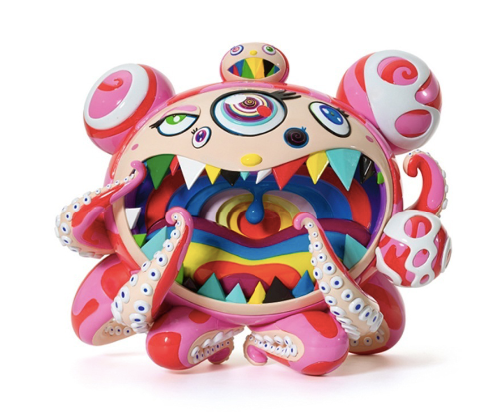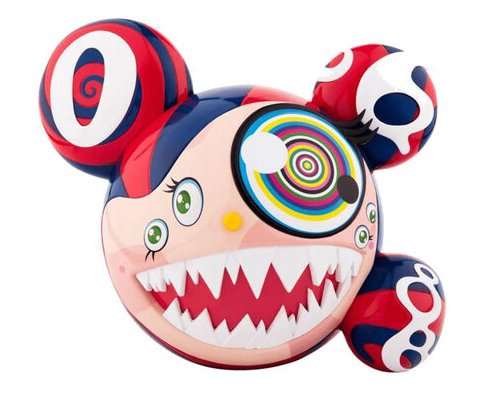
Murakami
Takashi Murakami is a fun and courageous artist. Fun because his colorful characters, inspired by the Manga universe, and the expanses of flowers that populate his paintings, bring an irresistible joy.
Courageous because he is one of the few artists to have crossed the border between oriental and western art, giving life to a new Pop Art which he himself has renamed Superflat.
Inspired by the works of the artists of the Edo period, Superflat is not only a pictorial and compositional style free from perspective, but the metaphor of an art where any barrier between more or less important works disappears. Superflat is a profound analysis of Japanese culture, from the post-war period to today, and a reflection on consumerism, fetishism and the fear of growing up typical of manga characters.
For Takashi Murakami art means imagining new things, creating or at least dreaming of the future. It doesn't matter if you are able to understand it, just getting close to it gives a complete and profound meaning to the role of the artist who returns to being a prophet with truly important social and sociological functions.
His creations, paintings, sculptures, films but also sweatshirts, Manga costumes and accessories, recover the pillars of oriental art - the flowers, rigorously hand-drawn in a ritual that has the flavor of purification rites, the bright colors that recall the precious fabrics of the Silk Road - and combine them with the Pop style and approach.
Not for nothing for the artist, born in Tokyo to a taxi driver and a housewife, an artist to supplement the family income, his arrival in the United States in the 90s was revealing.
Before then, his training, Nihon-ga (painting) at the National and Fine Arts and Music University in Tokyo had focused solely on the Japanese tradition.
The encounter with Pop Art had the flavor of revelation and, in 1993, Hiropon Factory was inaugurated which, in the wake of Andy Warhol's Factory, became a creative and experimental hub. A mathematical center given that his works are born from millimetric calculations. It is difficult to find detailed paintings like his. The creative process is a long forge, an artistic assembly line where Takashi's drawings are digitized by a team of assistants and positioned in paintings, or transformed into sculptures, through proportions and engineering calculations.
However, the result is anything but cumbersome. The paintings covered with flowers, rather than the Mr. Dob - a mouse mix between Doraemon and the protagonist of the video game Sonic the Hedgehog - reach the public in all their powerful creativity and spontaneity.
The fashion world goes crazy for Takashi Murakami. Louis Vuitton entrusted him with the restyling of the brand and the capsule collection, which sold like hot cakes, of bags with the rainbow monogram, Issey Miyak but also Nissan and Kyane West wanted him. And those are just a few.
In 2010, the halls of Versailles where the capricious and unforgettable Marie Antoinette walked more than two hundred years earlier were invaded by her works in a solo show that, to many French traditionalists, seemed like a profanation.
Although many of his countrymen do not forgive him for having distorted tradition, in 2011, after the Fukushima earthquake and tsunami disaster, Takashi Murakami dedicated a series to his people. The paintings depict the Arhats who, in the Buddhist tradition, are the protector monks, in the presence of death and destruction in a surreal landscape. For the artist, the occasion was a way to reimmerse himself in his own culture of origin and find the perfect balance between East and West.
Exhibited in galleries and museums around the world, the artist has participated in the Venice Biennale, the Museum of Modern Art in San Francisco, Moma PS1 in New York, the Guggenheim in Bilbao, the Cartier Foundation in Paris, the Museum of Contemporary Art in Tokyo and the Museum of Fine Arts in Boston.
Considered Japan's Andy Warhol, Takashi Murakami is definitely an artist worth collecting.
It goes without saying that, with each passing day, its prices are always, deservedly, higher.
The artist's works
-
Vendor:Takashi Murakami
Mr. Dobtopus A
Regular price €4.200,00Regular priceUnit price / per -
Vendor:Takashi Murakami
Mr. Dobtopus B
Regular price €5.800,00Regular priceUnit price / per -
Vendor:Takashi Murakami
Mr. Dob Figure Red
Regular price €4.200,00Regular priceUnit price / per -
Vendor:Takashi Murakami
Mr. Dob Figure Gold
Regular price €4.400,00Regular priceUnit price / per




